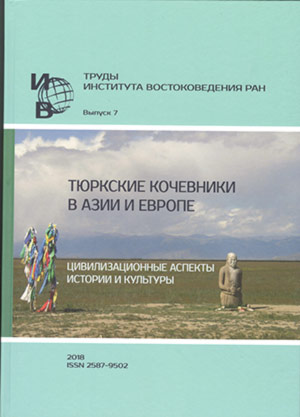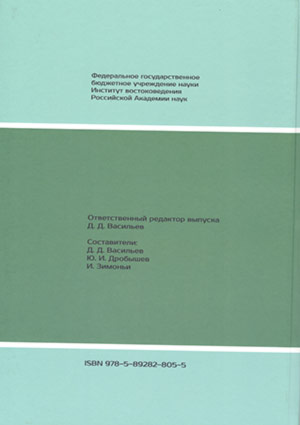Книга
 Труды Института востоковедения РАН. Вып. 7: Тюркские кочевники в Азии и Европе: цивилизационные аспекты истории и культур
Труды Института востоковедения РАН. Вып. 7: Тюркские кочевники в Азии и Европе: цивилизационные аспекты истории и культур
 Труды Института востоковедения РАН. Вып. 7: Тюркские кочевники в Азии и Европе: цивилизационные аспекты истории и культур
Труды Института востоковедения РАН. Вып. 7: Тюркские кочевники в Азии и Европе: цивилизационные аспекты истории и культур

Труды Института востоковедения РАН. Вып. 7: Тюркские кочевники в Азии и Европе: цивилизационные аспекты истории и культур
Ответственный редактор: Васильев Дмитрий Дмитриевич
Составитель: Васильев Дмитрий Дмитриевич, Дробышев Юлий Иванович, Зимоньи Иштван
Москва, 2018, 268 стр.
Очередной выпуск Трудов Института востоковедения РАН содержит сборник статей, подготовленный международным коллективом авторов, и посвященный актуальным проблемам кочевниковедения. Рассмотрен вклад номадов древности и средневековья в культуру оседлых цивилизаций, проанализированы контакты тюркских кочевников с соседними народами, освещен ряд вопросов их этногенеза, археологии, антропологии, идеологии, военного дела. Материалы сборника охватывают период с VII в. до современности и включают данные по Восточной Европе, Передней, Средней и Центральной Азии. Сборник отличается мультисциплинарностью, значительным разнообразием подходов и методик. Выдвигаются оригинальные гипотезы и предлагаются новые решения ряда вопросов номадологии. Текст богато иллюстрирован фотографиями артефактов, обнаруженных в результате раскопок, а также схемами и фрагментами средневековых европейских карт. Материалы выпуска могут интерес для историков-медиевистов, тюркологов, кочевниковедов, археологов, этнологов, культурологов.
English version
SUMMARY
The Department of Oriental history of the Institute of Oriental studies of the Russian Academy of Sciences in 2002, 2005, and 2008, based on the materials of international conferences “History and culture of Eurasian steppes”, has published three volumes, which received the common name “Hungaro-Rossica”. The volumes included the results of studies of Russian and Hungarian Orientalists on the history and source studies of medieval nomads of Eurasia. This volume is a direct continuation of this scientific tradition and is essentially the next, the fourth issue of “Hungaro-Rossica”.
The study of nomads’ history has a long tradition in Hungary, and researchers work in many research centers of the country. It should be noted the long-standing scientific relations and joint research projects of Hungarian and Russian Orientalists in this field. This led to the composition of the new volume, materials for which were presented by Orientalists of both countries. Traditionally, studies on the history of the nomadic peoples of Eurasia occupy a prominent place among Turkology and Mongolian studies. They are presented in this volume, which continues the joint Hungarian-Russian scientific project.
On a large factual basis, Horvath Ferenc, Hathazi Gabor discusses in their article migrations of nomadic tribes to the lands of the present Hungary and their acculturation. The article presents the representative results of archaeological works carried out by different experts for more than a century.
I. Fodor and D.D. Vasiliev point out that there are a lot of hypotheses about the origin of the sabre with Arabic inscription was found in Tuva, in the burial mound with a mounted stone stele, which contained a Turkic Runic epitaph sabre. The feature of the sabre is that the Runic inscription on the stele unveils the name of the sabre’s holder - Bagyr. Besides, the type of the sabre is unusual for the arms of Central Asian nomads. This is a reason for different legends and poetry about the sabre. Previosly, there were several opinions about the place, where the sabre could be manufactured. Hypotheses of different researchers about the origin of the Bagyr’s sabre are advancing into the following direction, that the sabre is the masterpiece of East European craftsmen. But there is no evidence of its “Kabar” origin.
V.V. Tishin discusses some theoretical problems of a studying of “tamga” signs’ material of the Old Turkic period. The author draws his attention to the terminology for the designation of “tamga” symbols used in the sources and tries to specify the relationship between different terms, considering them in the context of the problem of the functional significance of certain signs. Considerable attention is paid to the discussion on social nature of Old Turkic “tamga” signs to be considered as personal or tribal.
A. Marcsik analyzes the anthropological indicators of the medieval population of the Carpathian basin. The graves of peoples of Caucasoid and Mongoloid appearance were identified.
Tatiana Anikeeva considers “The book of Dede Korkut”, which consists of twelve songs-chapters, which tells about the exploits of the Oghuz heroes. The core plot of “The book of Dede Korkut” which is surrounded by these stories is the fight of the Oghuz people with the infidels surrounding them on all sides in the lands of Asia Minor, and feuds among the Oghuz. An external enemy for the Oghuz has specific and at the same time mythological features, thereby marking the boundary between the world of the nomads and neighboring sedentary world.
Yu.I. Drobyshev deals with some similar moments in the ideology of the Ancient Turks and the Iranians in VI-VIII centuries, concerning the figure of the supreme rulers of Turkic and Iranian societies: kaghan and shakhanshah. Possible borrowings of ideas about the limits of power, possibilities and duties of the supreme ruler are discussed. The author comes to the conclusion that Turkic borrowings in the Iranian-speaking world are noticeable in the period of the First Kaghanate, while in the era of the Second Kaghanate the strong influence of Chinese culture is obvious.
Based on a wide factual material, S. Kovacs and I. Zimonyi reconstruct the picture of interaction of nomadic and settled peoples on the territory of present Hungary. History of the Kuns (Kumans), which played a significant role in the events of medieval Eastern Europe, is considered in detail.
According to Sh.S. Kamoliddin, Turks were at the helm of the cultural process, which we now call “Islamic Renaissance”. Before adoption of Islam, the Turks had a strong statehood, the Turkic Qaghanate, and a high culture. In this respect, they were the forerunners of the Arabs. In Central Asia the process of the “Islamic Renaissance” was preceded by a similar cultural process that took place during the era of the Turkic Qaghanate (6th - 8th centuries), which can be provisionally called the “Turkic Renaissance”. During this period, which is characterized by rapid development of urban planning, architecture and art, many cultural values of the Kushan time are being revived, which fell into decay and were lost during the stagnant period of the reign of the Chionites and Ephtalites (4th - 5th centuries). Having rich experience in the revival and development of cultural traditions, accumulated in the era of the Turkic Qaghanate, the Turks were the initiators and active participants in a similar process in the era of the Arabic Caliphate.
The article of D.M. Timokhin is devoted to the history of formation of the Turkic military and political elite of Khorezm state during the rule of khorezmshakhs II-Arslan, Ala ad-Din Tekish, and Ala ad-Din Muhammad. The author in detail analyzes information from the Arab-Persian sources features of the distribution of military and administrative posts among the Turkic nomadic aristocracy. The evolution of this phenomenon and the changes that these rulers brought to the position of the Turkic elite in Khorezm are studied. The greatest attention is given to the board of Khorezmshah Ala ad-Din Muhammad, and his eldest son, Jalal ad-Din Mankbumi. The paper also presents an analysis of the key positive and negative aspects of the functioning of the Turkic military and political elite of Khorezm on the eve of the Mongolian invasion.
Yu.A. Aver’yanov considers the social structure of the confederation of Qashqai tribes living in the Iranian province of Fars and in neighboring areas. It indicates the special position of the ruling clan Ilkhanov Shahilu, who in fact turned into a princely dynasty. Despite the confusion with Indo-Iranian tribes, the Qashqais continue to consider themselves “Turks” and are proud of the legacy of nomadic culture. Relations between the Qashqais and the neighboring semi-nomadic tribes were rather tense. Ilkhans of the Qashqais assumed the functions of judicial and religious power over their fellow tribesmen. The heads of individual tribes have been generally elected.
P.K. Dashkovskiy, on the basis of written and archaeological sources, studies a possibility of identification in the social structure of the nomadic peoples of Central Asia of the late antiquity categories of priests that were professionally included in the religious sphere. The commission of the main mass of the cult of action, especially rites of the funeral cycle, produces large heads of families and genera.
R.Yu. Pochekaev presents his a study of information of Russian and Western travelers of the 19th c. on the legal status of nomads who were subjects of the Central Asian khanates - Bukhara, Khiva and Khoqand. The specific features of their legal position is studied as well as a level of integration of different peoples and tribes into the political and legal space of khanates of the Central Asia.
The paper of N.N. Kradin, A.L. Ivliev, and Vasiutin S.A. considers an origin of urban culture in the Xiongnu Empire. The significance of Xiongnu urbanization for Inner Asia is emphasized as creation of towns and fortified settlements with residential and production areas was a novelty for this region. An approximate sketch of stages of urbanization and origin of the early town in Xiongnu Empire based on analysis of materials of Tereljin-Durvuljin ancient town and other sites has been presented.
Bureaucracy as a civilizational phenomenon is studied in the article of Pikov G.G. who deals with the formation and development of bureaucracy in the Chitan Empire Liao (907-1125). The author studies the background of this process, the sources of the formation of Chitan bureaucracy, it’s place in the social structure, role in pohtical history, and the fate in the post-imperial period.
The article ofO.A. Koroleva is devoted to the question how Chinese culture influenced the cultures of neighboring states and their assimilation. The focus of the research is the reforms of Xiaowendi (better known as Toba Hun). The author describes the life of Xianbei, including the marriage system, as well as Sinicization of names, language, clothes, etc.
The materials presented, along with the already traditional problems, touch upon new aspects of the Eurasian nomadology problems. The authors put forward new questions and offer original solutions. The geographical and temporal coverage of the works is extremely large: from Eastern Europe to Eastern Asia, from the early middle ages to the present day. The volume is addressed to historians, medievalists, nomad scholars, archaeologists, ethnologists, and specialists in cultural studies. It can also be in demand by a wide range of readers interested in history and culture of the nomadic societies of Eurasia.
Содержание
СОДЕРЖАНИЕ
От составителей………………………………………………………………………………. 4
Хорват А.П., Хатхази Г. Печенеги и куны. Археологическое наследие…………………. 7
Фодор И., Васильев Д.Д. Где обрел свою саблю Багыр? Восточно-европейские трофеи
у кочевников Центра Азии………………………………………………………………….. 88
Тишин В.В. Некоторые вопросы изучения тамг кочевников Центральной Азии
древнетюркского времени…………………………………………………………………… 101
Марчик А. Антропологическая характеристика средневекового кунского и венгерского
населения (краткий обзор)……………………………………………………........................ 114
Аникеева Т.А. Образ врага в огузском книжном эпосе…………………………………… 120
Дробышев Ю.И. Тюркский каган и сасанидский шаханшах: к вопросу об
идеологических заимствованиях древних тюрков у иранцев…………………………….. 126
Ковач С., Зимоньи И. Кочевники и венгры в X-XIV вв…………………………………… 146
Камолиддин Ш.С. Роль тюрков Средней Азии в мусульманском ренессансе………….. 169
Тимохин Д.М. Представители тюркских кочевых племен в государственной и военной
системе Хорезма XII – начала XIII в………………………………………………………… 182
Аверьянов Ю.А. Особенности традиционной социальной структуры кашкайских
племен…………………………………………………………………………………………. 194
Дашковский П.К. Служители культа у кочевников Центральной Азии в эпоху поздней
древности……………………………………………………………………………………… 199
Почекаев Р.Ю. Кочевые подданные среднеазиатских ханов: особенности правового
статуса в записках путешественников XIX в. 215
Крадин Н.Н., Ивлиев А.Л., Васютин С.А. Империя хунну и начала степной
урбанизации…………………………………………………………………………………… 226
Пиков Г.Г. О степени и специфике развития бюрократизма в киданьской империи Ляо
(907–1125)……………………………………………………………....................................241
Королева О.А. Реформы Сяо-вэнь-ди: процесс китаизации сяньбийского общества...257
SUMMARY……………………………………………………………………………………..266
